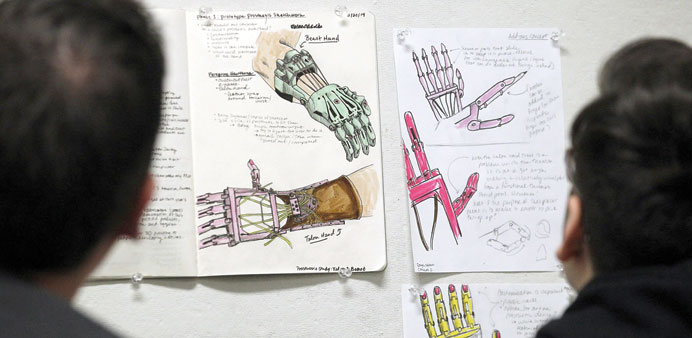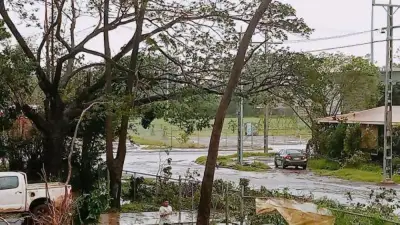The kid-friendly accoutrement with 45 component parts was made at an art school and came together as a result of a worldwide collaboration, writes Mary Louise Schumacher
Shea Stollenwerk recently made her very first “hand heart,” bending her pointer fingers together and putting her thumbs down into a pretty point.
The nine-year-old girl, who was born with a partial palm, a two-digit thumb and no fingers on her right hand, can do that because she has a brand-new set of fingers. Part RoboCop, part Barbie, her new hand is bright pink and called a “Cyborg Beast.”
It was created using a 3-D printer, a manufacturing tool that functions like a fancy glue gun, building up or “printing” objects layer by layer with liquefied plastic. Until fairly recently, such printers, which make things from computer-generated designs, were massive and massively expensive. Now, consumer models go for about $2,000.
Shea’s new hand, a prototype with a Velcro band that keeps it in place, was not the result of advances in the world of prosthetics and wasn’t fitted in a doctor’s office. The kid-friendly accouterment with 45 component parts was made at an art school and came together as a result of a worldwide collaboration between a man who makes monster suits for low-budget horror movies, a woodworking artist in South Africa, a robot-loving high school student in California, a guitar-loving tinkerer from Kentucky and an especially willing artist from the University of Wisconsin-Milwaukee, Frankie Flood.
“The fantastic part of all of this technology is that it’s very accessible,” said Joseph K. Brenner, director of clinical prosthetics at the Michigan Institute of for Electronic Limb Development in Detroit and a clinical prosthetics specialist. “It’s all very much in its infancy.”
Flood, an associate professor in the metals department at UWM’s Peck School of the Arts, first heard about Shea just before Christmas through Milwaukee Makerspace, a social group for people who build and design things. That group had, in turn, been contacted by a relatively new Google Plus community of “thinkers, tinkerers, engineers and artists” working on prosthetic hands called E-Nable.
It’s a story about the Internet bringing people together around an emerging technology and a particular problem to create a burst of innovation.
But let’s back up a bit.
Let’s back up to Ivan Owen, the monster maker from Bellingham, Wash., who posted a video to YouTube of an Edward Scissorhands-like mechanical claw he was particularly proud of. His creepy creation moved with the help of finger-controlled cables, kind of like a puppet. It was pretty cool, and the video went viral. It has more than 1.5 million views today.
On the other side of the planet, Richard Van As, an artist who lives near Johannesburg, South Africa, saw the video. He had lost four fingers from his right hand in a table saw accident and e-mailed Owen, asking if he could help him conjure a homemade hand. The men also heard about a five-year-old boy named Liam who needed a hand, too.
“This was a very large task for two guys operating from their garages separated by ten thousand miles, but we figured it was at least worth exploring,” Owen said in a TEDx talk in Seattle in January.
Eventually, MakerBot, a company that makes 3-D printers, gave the men two free printers to explore the technology for their project. That meant they could both hold the prototypes in their hands while they brainstormed via video chat. It also meant they could refine and reconfigure their designs quickly.
When they completed the first successful 3-D printed hand about a year ago, they posted videos online and shared their designs at Thingiverse, a website where people give away 3-D designs. Eventually, this led to the creation of the Google Plus group, started by Jon Schull, an associate professor at the Rochester Institute of Technology in Rochester, NY, that attracted a team of researchers from Creighton University in Omaha, Nebraska, the guitar specialist, the high school student, families who were experimenting with the hand-making kits at home and others.
This is when the budding movement came to the attention of Shea’s mom, Ranee Stollenwerk, by word of mouth on Facebook.
She had not been in any hurry to experiment with medical prosthetic devices, which can cost tens of thousands of dollars, hoping Shea would develop a full range of abilities with her hand as it is. Besides, there wasn’t much her daughter couldn’t do. Shea can ride her bike, with a bit of discomfort, for instance.
But then Shea asked for a hand from Santa for Christmas — three days before the holiday. Ranee quickly combed the Internet for help and found the E-Nable group.
“I have been looking into trying to figure this out ... but it is way above my head!” Ranee wrote to the E-Nable group, adding that Shea wanted to help make her hand if that was possible. “I’m a part-time preschool teacher and full-time mom. Not an engineer.”
That inquiry led the Mukwonago, Wisconsin, mom to a high school student and robotics league enthusiast from Los Gatos, California, Nick Parker. He invited her into the Google group, which put her in touch with Pete Prodoehl of the Makerspace group here and, in turn, Flood.
Flood’s first thought was that this was precisely the kind of project he encouraged his students to get involved in. It would be an open-source, collaborative process that would create something truly useful and improve someone’s life. And while it might seem strange to see such things made in an art studio rather than a doctor’s office, it’s the kind of custom-made object that artisans, craftsmen and metalsmiths have made for centuries, he says.
By that time, there were a few prototype designs available at E-Nable: the original “Robohand” created by Owen and Van As; the “Talon” designed by Peter Binkley, a dad from Virginia who created a hand for his son; and the “Cyborg Beast” by Jorge Zuniga, an assistant professor of exercise science at Creighton University. With those designs in hand, Flood went to work.
He got giant spools of plastic filament in Shea’s favourite colours — pink, yellow and orange — and started printing out parts as fast as he could. He has a 3-D printer in his bedroom at home and was, for a while, printing through the night.
The hand was not ready in time for the holiday, but Ranee and her husband, Steven Stollenwerk, could tell Shea that one was in the works. It takes about nine hours to print all the parts for the hand and several hours of assembly, which includes Chicago screws and window-shade cord.
When Shea visited UWM in February to try out the first prototype, the pink “Beast,” it took her a matter of seconds to start picking things up. It works with wrist movement. A downward motion creates cable tension and closes the fingers. An upward motion does the opposite, opening the hand.
“We were like a rowdy cheering section,” Shea’s dad says of those moments, captured on video and posted to E-Nable.
“It made my year to see her pick something up with her new hand,” Flood wrote in his blog that night. “It had to be one of the coolest feelings I’ve ever experienced.”
Flood has paired up with associate professor Adream Blair and a group of undergrads taking a design course in the Digital Craft Research Lab at UWM, which along with the Milwaukee Makerspace community has paid for the project. Flood was supposed to be on sabbatical this semester but has put aside personal projects to work on Shea’s hand.
Meanwhile, Shea is experimenting with her pink hand, using it to flip light switches around the house and to shake dice while playing board games. Sometimes, she forgets it at school.
The one thing she wants to do someday? “The monkey bars,” says Shea (who is a little shy and said we could talk to her but asked that we get her little sister, six-year-old Myla, into the newspaper, too).
The first prototype is a little tight, so Shea doesn’t wear it for long. Soon, Flood will have more hands for her to try.
As she grows, the designs can easily be scaled up and remade, usually for less than $50. Eventually, the family may seek some advice from a medical professional to ensure the hand is appropriate for Shea’s development, something the E-Nable group recommends.
Going forward, Flood hopes to borrow the best attributes from all of the existing designs, test and refine them with Shea’s help, and create a whole new design especially for her.
They’ll upload it to the Internet, where it will be shared and free. They plan to call it “Shea’s Hand.” — Milwaukee Journal Sentinel/MCT



